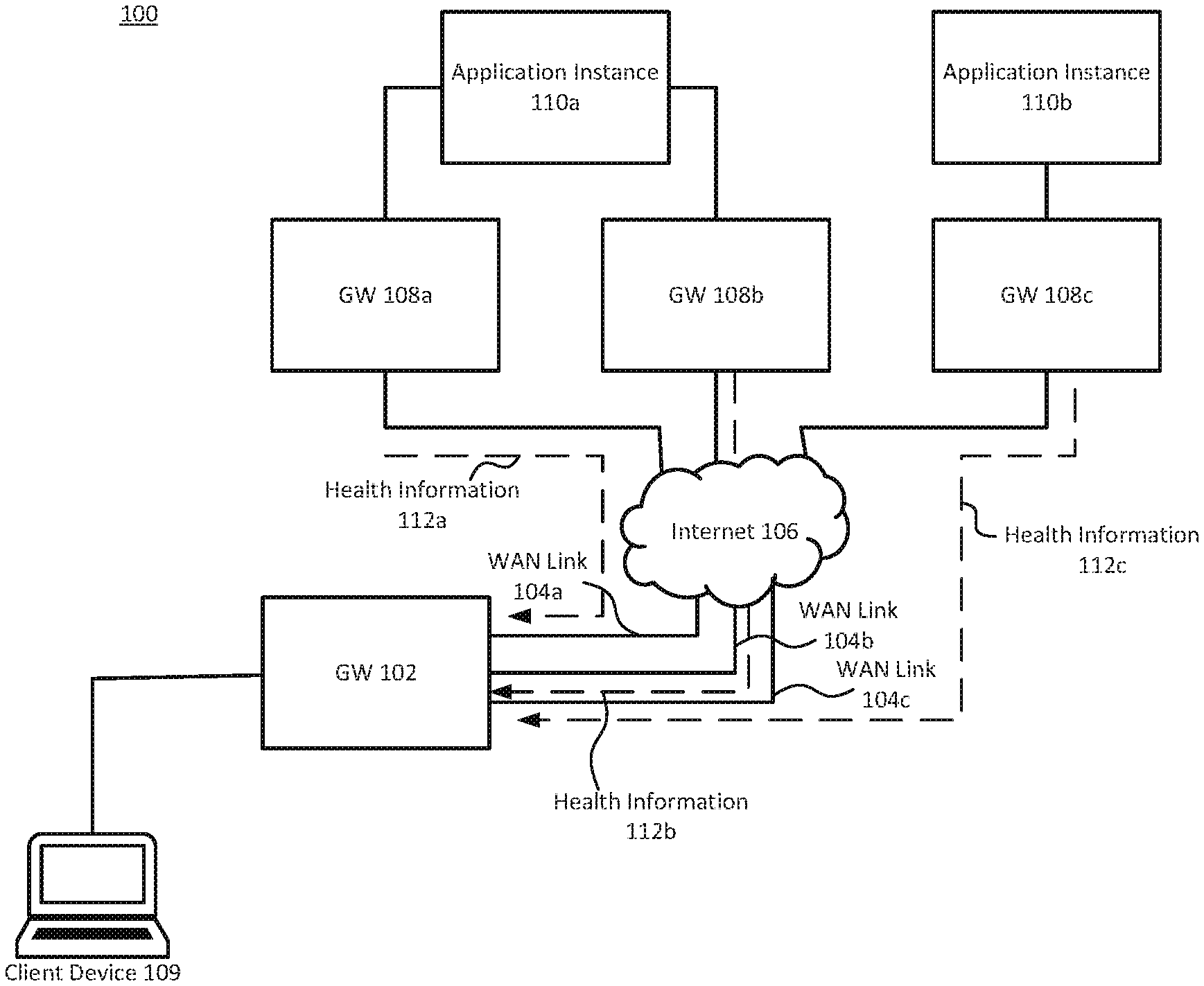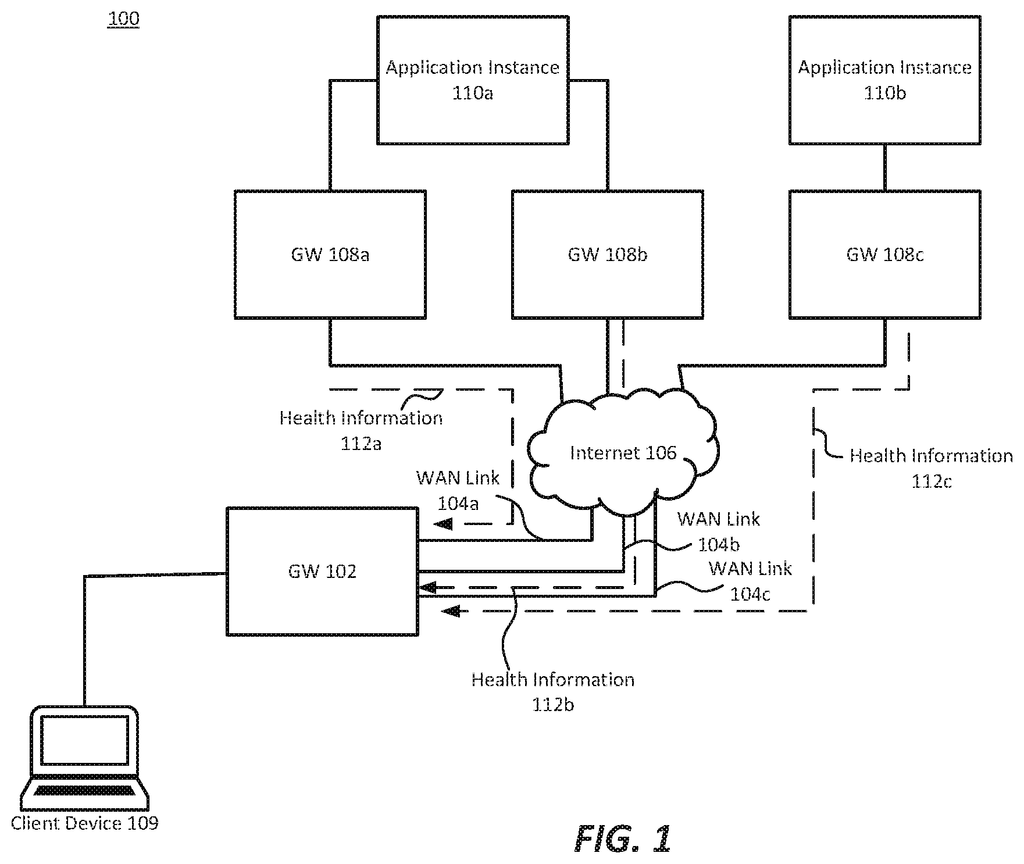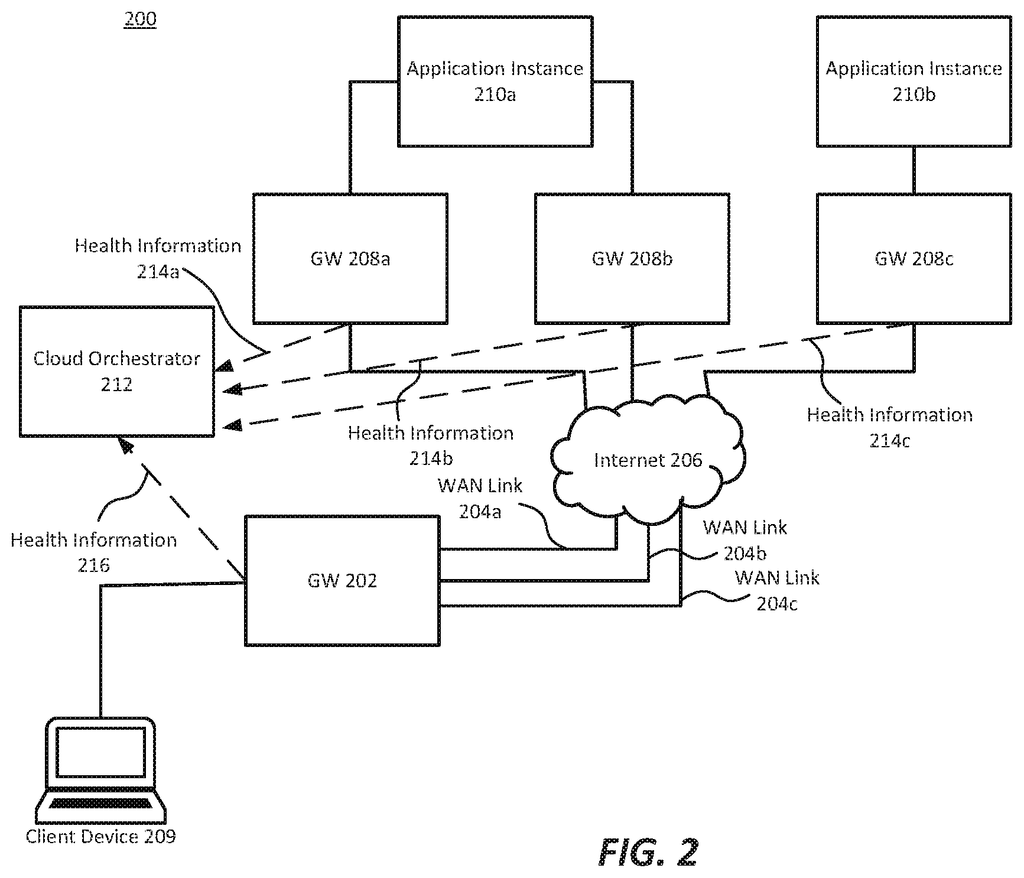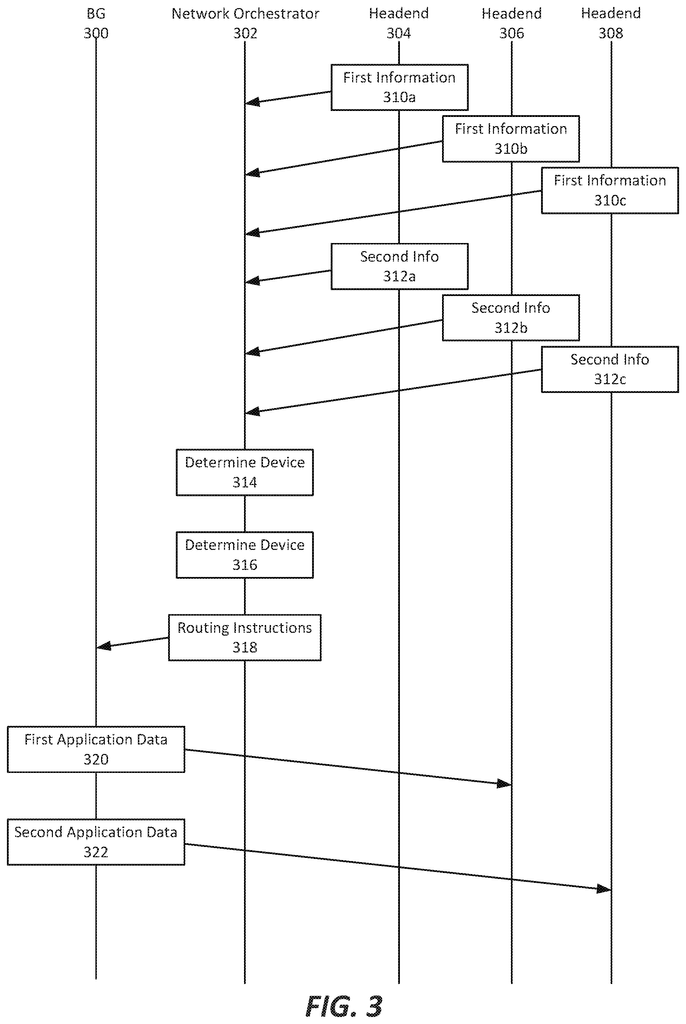Invented by Hari Krishna Kurmala, Shreekanth Chandranna, Hewlett Packard Enterprise Development LP
Dynamic Application Routing in SD-WAN allows businesses to optimize their network performance by intelligently directing traffic based on real-time conditions. This means that critical applications can be prioritized and routed through the most efficient path, while less important traffic can be directed through alternative routes. This dynamic approach ensures that network resources are utilized effectively, resulting in improved application performance and user experience.
One of the key drivers for the adoption of Dynamic Application Routing in SD-WAN is the increasing demand for cloud-based applications. With more businesses relying on cloud services, the traditional hub-and-spoke network architecture is no longer sufficient to handle the increased traffic and complexity. SD-WAN with Dynamic Application Routing enables organizations to securely connect to multiple cloud providers and optimize the performance of cloud-based applications.
Another factor contributing to the growth of this market is the rise of remote and mobile workforces. As more employees work from different locations and devices, the need for a flexible and scalable network infrastructure becomes crucial. Dynamic Application Routing in SD-WAN allows businesses to easily adapt to changing network conditions and ensure that remote workers have seamless access to critical applications.
Furthermore, the market for Dynamic Application Routing in SD-WAN is driven by the increasing need for network security. With cyber threats becoming more sophisticated, businesses need robust security measures to protect their data and applications. SD-WAN technology provides built-in security features, such as encryption and firewall capabilities, that can be dynamically applied to different application traffic. This ensures that sensitive data is protected and compliance requirements are met.
The market for Dynamic Application Routing in SD-WAN is highly competitive, with numerous vendors offering solutions tailored to different business needs. These vendors provide a range of features, such as application-aware routing, traffic optimization, and analytics, to help businesses achieve optimal network performance. Additionally, many vendors offer managed SD-WAN services, allowing businesses to outsource the management and maintenance of their network infrastructure.
In conclusion, the market for Dynamic Application Routing in SD-WAN is experiencing significant growth as businesses recognize the need for more efficient and flexible network solutions. With the increasing demand for cloud-based applications, remote workforces, and network security, SD-WAN technology with Dynamic Application Routing provides organizations with the tools to optimize their network performance and ensure a seamless user experience. As the market continues to evolve, businesses should carefully evaluate their network requirements and choose a solution that best meets their needs.
The Hewlett Packard Enterprise Development LP invention works as follows
The actions include receiving first information indicating resource utilization of headend gateways for forwarding data of a first application, receiving second information indicating resource utilization by branch gateways for forwarding data of a second application, and sending the data from the first application across a WAN link to a headend gateway best suited to forward the data from the first applicaiton. These actions include receiving information on resource utilization for headends gateways when forwarding a data from a first applicaiton, receiving information on resource utilization for branch gateways when forwarding a data from a 2nd application, forwarding the data for the first applicaiton across a wide area network to the best headend gateway for the first applicaiton, and forwarding the data for the second to the best headend for the second.
Background for Dynamic Application Routing in a Software Defined Wide Area Network
A wide-area network (WAN), may span multiple network sites, such as geographical, logical). The WAN is interconnected, so devices on one site can connect to resources on another. In some topologies many services and resources (e.g. Datacenters and headquarters are often the core sites, while many branches (e.g. regional offices, retail stores) connect client devices (e.g. Laptops, smartphones and internet-of-things devices are connected to the WAN.
Each site of the network has its own local network (LAN), which is connected to other LANs to form the WAN. Switches and routers act as the networking infrastructure to route network traffic between each LAN, the WAN, and the Internet. The LAN of each network site is connected to a wider network. Gateway routers connect the LAN to the wider network (e.g. Headend gateways, also known as virtual Internet gateways, connect the core sites with the wider network. Branch gateways connect the branch sites.
SD-WAN technology is often used to implement WANs. SD-WAN separates (logically or literally) the control of switching and route from the actual routing of network traffic. In some SDWAN implementations each gateway (BGs or head-end gateways), controls certain aspects for routing in their respective LAN. However, a network orchestrator is responsible for the overall switching and WAN routing.
Connections between network sites are formed to transfer data related to a specific application. It is possible that the application runs from a datacenter. an ?on-prem? Payroll software) from a cloud-based server (e.g. Traditional cloud-hosted web services, as a service or via other provisioning models. Software as a Service (SaaS) or other provisioning models are also possible. There are often multiple paths from an end-user device to an app through the WAN.
In a software-defined wide area network, there can be more than one way to connect two devices. There may be more than one direct link between two sites in a network (e.g. There may be redundant gateway devices, connections with different technologies, internet service providers and connections that use different technology. Network site A connects to network site B through network site C. The SD-WAN can use any of the paths available to connect the two devices. This is based on a number of factors including the type application that uses the connection, and the health status of the WAN connections between the network sites.
When an application is accessible and/or hosted on multiple networks, it introduces a layer of complexity in the routing decision. An ‘on-prem’ application, for example, can be hosted in multiple enterprise datacenters globally. Payroll applications may be hosted at multiple datacenters in different enterprise locations around the world. Multiple network sites can also allow access to a web-based cloud application. SD-WANs must consider not only the cost of the route to reach a network site but also the fact that there are multiple sites which can be connected to the application.
In non-software-defined WANs, the network sites were treated as adjacent and the routing protocols passed information on the health of the network from end to end. In SD-WAN the network sites can’t be treated as being adjacent and many of those protocols used in legacy WANs are not applicable when the Internet is involved. SD-WAN inter-site sharing is typically health information on the WAN link.
In an illustration consistent with this disclosure a headend gate at a network location that hosts or connects to one of more applications gathers data about its health, resource usage and network quality. This information can be provided to a cloud network orchestrator or to branch gateways in the WAN depending on the topology of SD-WAN. “A person with ordinary skill would recognize topologies and situations where each approach would be beneficial.
This health information from the headend gateway is then combined with additional path-specific health information, e.g. WAN link health, branch gateway health, etc.) To assign the best path to an application from a device of the end-user.
This invention is a technological improvement to the dynamic path selection technology in SD-WANs. When. Implementation of this invention can improve performance in situations where.
FIG. “FIG. SD-WAN 100, also referred to more generically in this disclosure as a Wide Area Network (WAN), includes a Branch Site that includes a Branch Gateway 102 and a Client Device 109. The branch site is linked to other sites by WAN links 104, which traverse Internet 106. Headend gateways are situated in other sites, and they are connected to application instances 110. “Health information 112 from headend gateways is sent to branch gateways 102 by WAN links 104.
Branch gateway 102 routes the data from and to the branch site using WAN links 104 a – c. Data being routed can include application data used by devices 109. A payroll application, for example, may be hosted at multiple locations across the WAN. Client device 109 could belong to a HR employee who is responsible for administering payroll at the branch location. In SD-WANs that are traditional, branch gateway 102 has been pre-programmed with the application traffic routing to a specific network site. This is usually a core site such as headquarters. In traditional WANs the network topology often follows a ‘hub-and-spoke’ pattern. The network topology is often arranged in a?hub and spoke? The traffic from the branch site to any other site in the WAN is routed by branch gateway 102 through a core site (the?huh?)
However certain features of SD WANs have enabled different network topologies, including full mesh (every site is connected with every other site), and regional mesh (each site is linked to all other sites in the same geographic region as well as core network sites worldwide). Dynamic path selection (DPS), for example, allows traffic to be routed from site to site via the best performing WAN link. Load balancing allows for traffic to be divided between redundant WAN links 104 in order to better utilize available bandwidth. These technologies, however, are limited in that they cannot tell the network the best route from a client device (109) to an application instance (101).
In some SD-WAN deployments that are traditional, probes between headend gateways 108 and branch gateways 102 are sent to determine the status of respective WAN connections 104. These probes are useful in determining the best route to a particular destination. However, they do not test the network beyond the interfaces on the headend gateways that face the WAN. While probes can mimic traffic for a particular application or type, they don’t behave exactly like data traffic from the application. “For example, if the cryptographic hardware at the headend gateway was required to handle the data traffic for the application, the probes may not test that hardware.
Furthermore the health and behaviour of the local network (LAN), of each network site associated with the headend gateway 108, is not tested.” In some examples, the first path, with its better-suited WAN connection 104, may not be as well-suited to forward data from an application, than a second route, with its less-suited WAN connection 104 but better headend gateway and headend site LAN.
In examples that are consistent with FIG. In the first disclosure, each headend gate 108 collects health metrics per application as well as device wide metrics. Each headend gateway transmits health data 112 periodically to branch gateway 102 over a respective WAN connection 104. Branch gateway 102 determines the best path for an application instance 110 using both probe data related to WAN link 104 and health 112.
In an illustration consistent with FIG. If client device 109 attempts to access a service in the cloud, application instances 110 can be connectors between each core network site. The cloud-based service can be accessed from the datacenter or headquarters. Headend gateways (108 a and 108) b can be dual headends for one network site. Headend gateway 108 c can be a separate headend gateway (?site B?) and corresponding WAN link 104 c could be a link from branch gateway 102 site B. Headend gateway 108 c could be a headend gateway for a different network site (?site B?).
In this example, the application instance 110 is a cloud-based connector that connects site A with the cloud service. The application instance is 110b is the connector for site B. The client device 109 may access the cloud service by using either application 110. In traditional WANs the branch gateway 102 defaults to a “best” configuration. A network administrator will select a core site based on factors such as geography and other considerations. In some SDWANs, the branch gateway 102 can automatically select a WAN connection 104 from all the available WAN connections connecting to the ‘best’ cloud service data traffic. WAN link information gathered by probing is used to determine the health of a WAN. It is possible, however, that the best path to cloud-based services does not match the most appropriate WAN link 104 in the pre-configured “best?” core site. “The core site” is configured to the?best?
In this case, the branch gateway 102 consolidates WAN link health data with health data 112 from the headend gateway 108 to determine the best path through WAN 100. Each parameter is weighted based on the characteristics of the cloud service to determine the suitability score. If the cloud-based services is video conferencing, then latency, packet drop rate and other parameters are heavily weighted. But if it is document storage or other parameters are less weighted, then latency, packet drop rate and other parameters are not as weighted.
In this case, WAN Link 104 a was the fastest, WAN Link 104 b was the second-fastest, and WAN Link 104 c was the slowest. Due to the cryptographic load of headend gateway 108 a, as reported in health information 112.a, the path utilizing WAN Link 104 b was the best scoring route, followed by WAN Link 104 c, and the worst scoring route was the path utilizing WAN Link 104 a. Branch gateway 102 selects WAN 104 b as the route for cloud-based services traffic between application instance 110 and client device 109. Another application might not be using the cryptographic resources on the headend gateway, so branch gateway may choose WAN 104a.
In some examples, the health information 112 only contains information about the headend gateway 108. In other cases, health information 112 may also contain information about the LAN side network up to and including the application instance 110 or the application server. In some examples, health information 112 can be sent separately for each application or health information 112 could include information specific to the application. In the example above, each application sent between the branch site to other network sites can be routed independently through the WAN. This routing decision may be made only once. However, branch gateway 102 can periodically recalculate and adjust the path that each application takes based on the manners known to someone with ordinary knowledge of the technology.
Click here to view the patent on Google Patents.









